Starting a soap business can be a rewarding venture, whether you’re passionate about natural skincare, seeking a creative outlet, or aiming to build a profitable brand from home.
With the rising demand for handcrafted and organic products, soapmaking offers a unique opportunity to turn a hobby into a thriving business.
When you consider that the global soap market amounted to $48.05 billion in 2024 and is predicted to reach $76.45 billion by 2032, according to Fortune Business Insights, it’s clear that this market offers plenty of potential for aspiring entrepreneurs!
However, success requires more than just crafting beautiful bars—it involves careful planning, branding, and strategy.
In this guide, we’ll walk you through the essential steps to launch your soap business, helping you build a strong foundation for growth.
Table of contents
- 1. Research the market
- 2. Define your niche and brand
- 3. Learn soapmaking techniques
- 4. Create a business plan
- 5. Register your business
- 6. Handle legal and safety requirements
- 7. Set up your production space
- 8. Develop and test your products
- 9. Choose your sales channels
- 10. Launch and promote your business
1. Research the market
Just like when you want to start a candle business, the first step in launching your own soap business involves taking a close look at the market in order to develop a thorough understanding of your target customers, competitors, and current trends in the soap industry.
When researching your target customers, you’ll want to ask yourself questions such as the following:
- What are their biggest concerns or needs when choosing soap? (e.g., skin sensitivity, natural ingredients, scent preference, sustainability)
- Where do they usually buy soap, and how often? (e.g., online vs. in-store, subscription boxes, boutique shops)
- What price range are they comfortable with for handcrafted or specialty soap? This helps position your pricing competitively.
- What ingredients or claims do they value most? (e.g., organic, cruelty-free, essential oils, fragrance-free)
- What influences their purchasing decisions? (e.g., brand values, packaging design, customer reviews, social media)
Consider creating a buyer persona, a profile of your ideal shopper, based on the data you find to help you better focus your sales and marketing strategies.
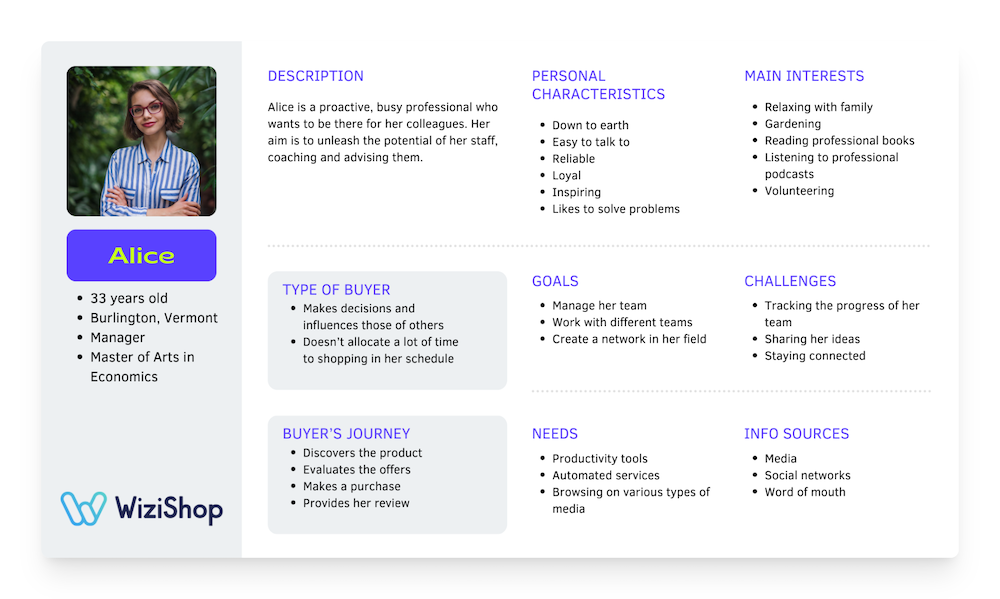
Example of a buyer persona template
It’s also important to research companies who are likely to be your competitors—but not to copy their creations and offerings!
Checking out the competition allows you to learn what products already exist, how they're priced, and what customers like or dislike.
This insight will aid you in identifying market gaps, differentiating your brand, avoiding common mistakes, and positioning your soap business effectively to attract and retain customers in a competitive market.
Finally, discovering what trends are at the forefront of the soap industry helps you align your soap products with what customers are actively seeking, such as eco-friendly packaging or natural ingredients.
Staying updated ensures your brand remains relevant, competitive, and responsive to evolving consumer preferences, giving you a better chance of success!
2. Define your niche and brand
Next, you’ll need to get to work on choosing a specific niche and developing a brand identity.
When it comes to picking a niche, be sure to think about not just your interests and experience but also the information you obtained during your market research to ensure that you appeal to the shoppers you’re hoping to attract.
Not sure where to start? Here are a few soap niche ideas to inspire you:
- Organic and natural soaps: Made with certified organic ingredients and free from synthetic additives
- Vegan and cruelty-free soaps: No animal products or animal testing involved
- Luxury/artisan soaps: High-end, visually artistic soaps with premium scents and packaging
- Sensitive skin/allergy-friendly soaps: Hypoallergenic and fragrance-free for delicate skin types
- Men’s grooming soaps: Bold scents and skin benefits tailored for male consumers
- Kids’ and baby soaps: Gentle, fun-shaped soaps with safe ingredients for young skin
- Eco-friendly/zero-waste soaps: Minimal packaging, biodegradable, and sustainably sourced
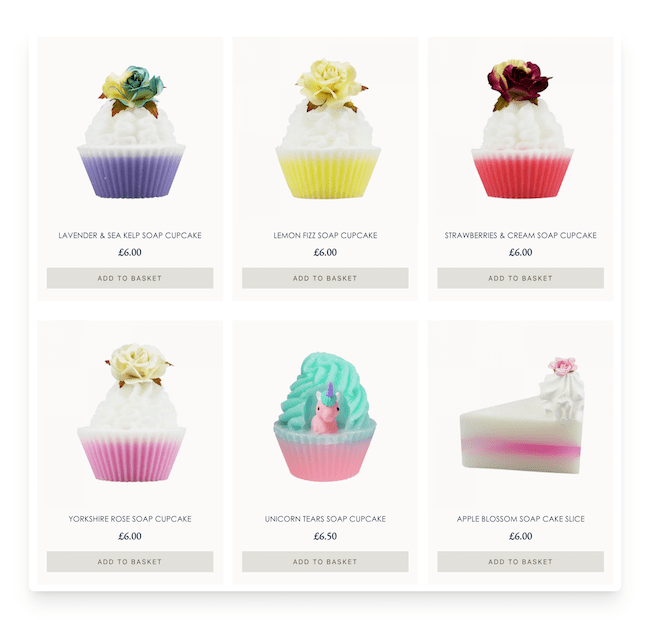
Sweet treat-inspired niche soaps in The Yorkshire Soap Co.’s Patisserie line
Once you’ve got a profitable niche in mind, you can begin working on your brand identity: the collection of visual elements, messaging, and values that represent how you want your business to be perceived by your audience.
The various elements of brand identity to consider during this step include the following:
- Brand name: The name of your business or product
- Logo: A visual symbol that represents your brand
- Color palette: Specific colors used consistently across branding
- Typography: Fonts and type styles that reflect your brand’s personality
- Tagline or slogan: A short, memorable phrase that captures your brand’s essence
- Voice and tone: The style and attitude of your written and spoken communication
- Packaging design: The look and feel of your product’s physical presentation
- Imagery and graphics: Photos, icons, and design elements that support your brand style
- Core values and mission: The beliefs and purpose that guide your business
- Customer experience: The impression and feeling your brand creates through interactions and service
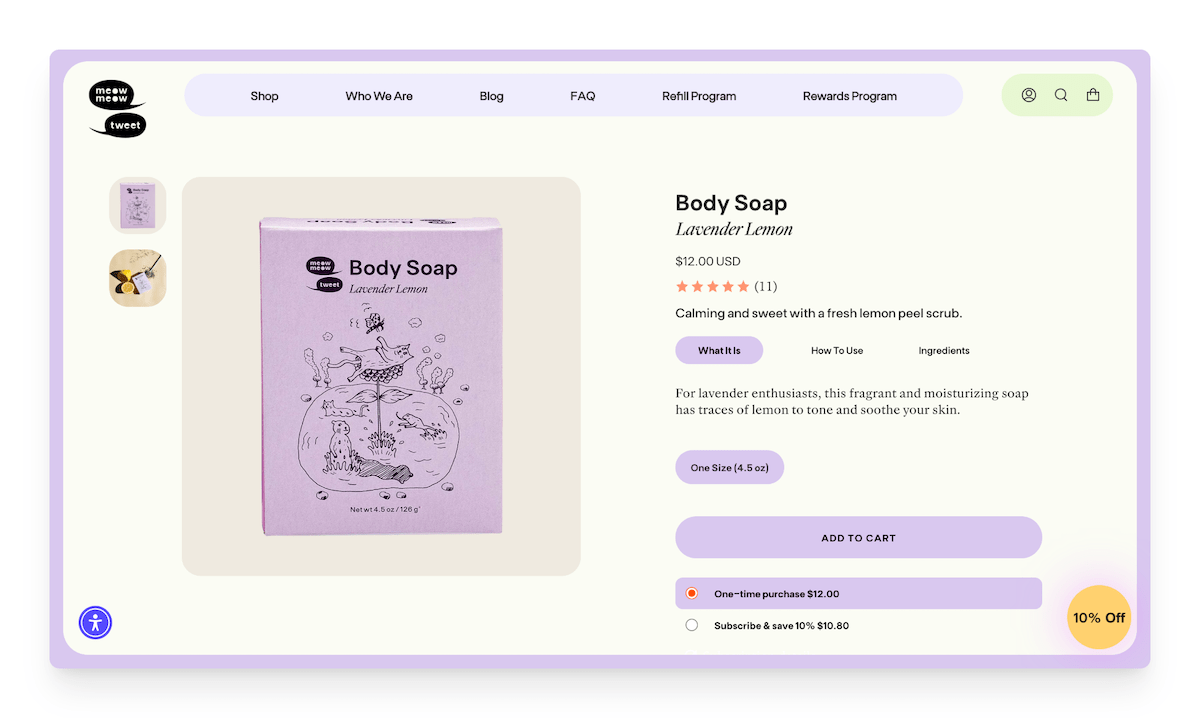
Example of soap with a unique packaging design, a key element of brand identity, by Meow Meow Tweet
3. Learn soapmaking techniques
If you’ve never crafted soap by hand before, you might be wondering if starting a soap business is a good idea…
The good news is that making soap isn’t super complicated.
Nevertheless, it’s advantageous to give yourself plenty of time to master different methods and find your favorite before you put your first product line up for sale!
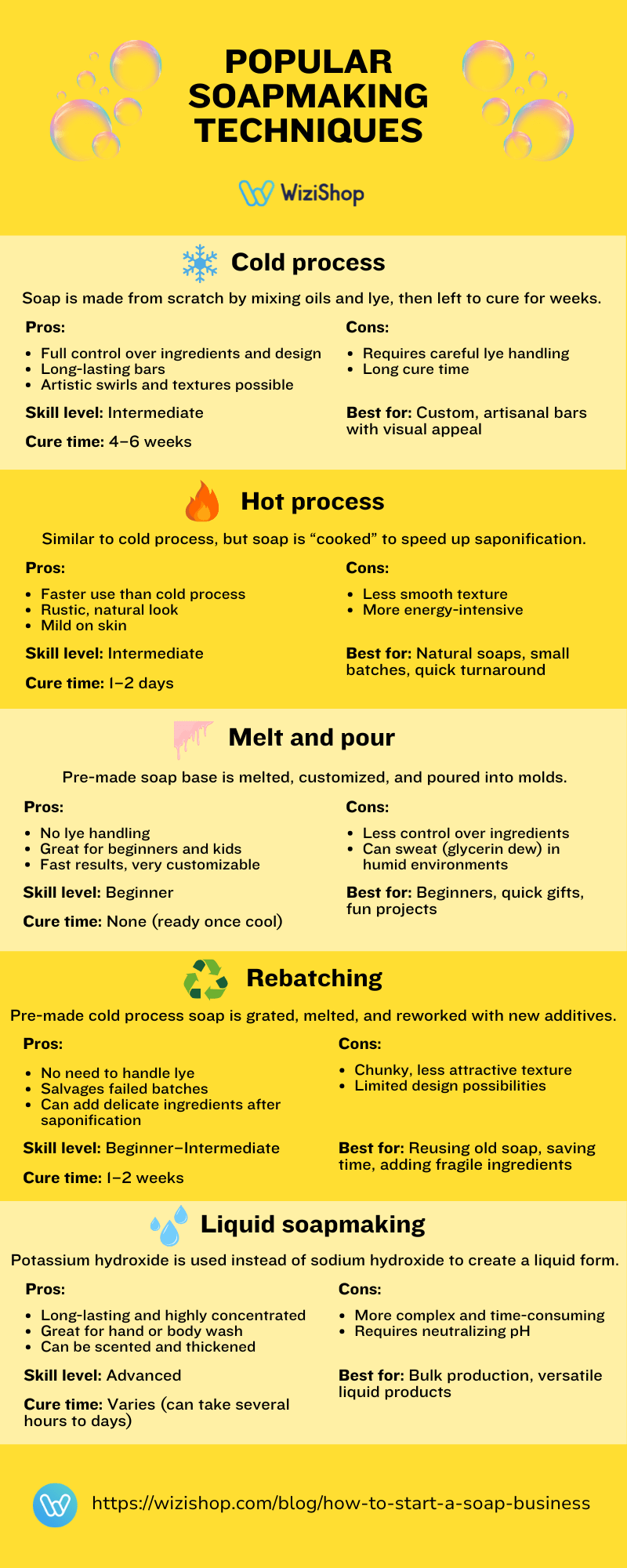
Cold process
With cold-process soapmaking, you mix oils or fats with a lye solution (sodium hydroxide and water). This causes a chemical reaction called saponification, turning the mixture into soap.
The blend is poured into molds and left to harden for 24–48 hours. After unmolding, the soap is cured in a dry area for 4–6 weeks, allowing excess water to evaporate and the soap to become milder and to last longer.
Pros
- It allows full control over ingredients, making it ideal for customizing natural and skin-safe formulas.
- The soap retains natural glycerin, which is moisturizing and beneficial for skin.
- You can create intricate designs and swirl patterns due to its slow tracing time.
- A wide range of oils, butters, and additives can be used for tailored skin benefits.
- Cold-process soap is long-lasting and has a luxurious lather once fully cured.
Cons
- The soap requires a curing time of several before it’s safe and effective to use.
- Working with lye requires strict safety precautions, including protective gear and ventilation.
- Mistakes in measurement or mixing can result in lye-heavy, unusable soap.
- Cleaning up afterwards can take a while, especially if your soaps feature elaborate designs.
- Scents and colors may fade or change during saponification and curing.
Hot process
Hot-process soapmaking involves combining oils or fats with a lye solution and then applying heat to speed up saponification.
The mixture is cooked—often in a slow cooker—until it reaches a thick, gel-like consistency. Once fully saponified, it’s scooped into molds and allowed to harden.
Unlike cold-process soap, the hot-process version can be used as soon as it cools and hardens, though a brief curing period improves hardness and longevity. This method produces a rustic, textured appearance.
Pros
- The soap is fully saponified during cooking, allowing it to be used almost immediately after cooling.
- It’s easier to ensure the final product is lye-free, reducing the risk of irritation.
- Additives like fragrances and colorants can be added after cooking, preserving their scent and appearance.
- It’s a forgiving method for beginners, as the cooking process can correct some formulation errors.
- The shorter turnaround time is ideal for small-batch or custom orders.
Cons
- The final soap often has a rough, rustic texture, limiting design possibilities.
- It requires constant attention and stirring during the cook phase.
- Scent retention can still be tricky due to high cooking temperatures.
- It typically uses more energy and equipment, like a slow cooker or double boiler.
- The thick consistency makes it harder to pour neatly into molds.
Melt and pour
For an easier way to get started with soapmaking, you might opt to try the melt-and-pour technique, where you melt a pre-made soap base, add colorants, fragrances, and other additives, and then pour the mixture into molds to harden.
This method skips the chemical saponification process since it’s already been completed. Once the soap cools and solidifies—usually within a few hours—it’s ready to use.
It’s a quick, beginner-friendly method that allows for creative designs and layering but offers less control over ingredients compared to cold or hot process soapmaking.
Pros
- It’s fast and simple, with no need to handle lye or wait for curing.
- The soap can be used as soon as it hardens, usually within a few hours.
- It allows for detailed designs, layers, and clear or translucent effects.
- It’s ideal for beginners and safe to do with older children (with supervision).
- Fragrances and colors stay vibrant since there’s no harsh chemical reaction involved.
Cons
- You have limited control over the ingredients in the pre-made base.
- It tends to sweat (form glycerin dew) in humid conditions.
- The lather and skin benefits may be lower than handmade cold- or hot-process soaps.
- Overheating the base can scorch or ruin it, requiring careful temperature control.
- Additives like fresh botanicals can spoil, as the soap doesn’t go through saponification.
Rebatching
Last on our list of soapmaking techniques for bar soap, rebatching entails grating or chopping pre-made cold or hot process soap, then melting it with a bit of liquid—like water or milk—using gentle heat.
Once it reaches a thick, mashed-potato-like consistency, you can add scents, colors, or additives, then spoon it into molds to harden.
Great for fixing failed batches or adding delicate ingredients that wouldn’t survive saponification, rebatched soap is ready to use once fully cooled and hardened, usually within a day or two.
Pros
- It allows you to reuse or salvage soap batches that didn’t turn out as planned.
- Delicate additives like essential oils or herbs can be added without being affected by lye.
- There’s no need to handle raw lye, making it a safer option.
- It’s a good way to reduce waste by repurposing soap scraps.
- The soap is already saponified, so it's usually ready to use once hardened.
Cons
- The texture is often rough and less smooth than cold- or hot-process soaps.
- Grating and melting the soap can be time-consuming and messy.
- It’s harder to achieve precise or intricate designs.
- The finished bars may look less polished or professional.
- The scent and color can still fade during the melting process.
Liquid soapmaking
While the previous techniques focus on creating solid soap, you might decide to craft liquid soap to sell, which requires a different process altogether.
To make liquid soap, you’ll typically use potassium hydroxide (KOH) instead of sodium hydroxide (NaOH) to create a soap that stays in liquid form.
Oils or fats are combined with a KOH solution and gently heated until they reach a thick paste through saponification. This paste is then diluted with water to achieve the desired consistency.
Liquid soap can be scented, colored, and adjusted for clarity or thickness.
Pros
- Liquid soap is convenient and easy to dispense for handwashing, showers, and cleaning.
- It’s made using potassium hydroxide, which creates a versatile, water-soluble soap.
- The finished product can be diluted or thickened to suit various uses.
- It’s perfect for adding water-based extracts and soluble additives.
- It produces less soap scum compared to bar soap, especially in hard water areas.
Cons
- The process is more complex and time-consuming than bar soap methods.
- It requires precise pH balancing to avoid skin irritation.
- The soap paste must be diluted, which can take several hours to days.
- Preservatives are often needed to prevent microbial growth in the final product.
- It uses more equipment and cleanup, such as multiple pots and containers.
4. Create a business plan
When launching a new business, no matter what kind of products or services you wish to sell, writing a business plan is a must!
This is a written document that outlines your business goals, strategies, and the steps needed to achieve success.
For a soap business, creating a business plan is essential because it provides a clear roadmap, helps you stay focused, and is often required to secure funding or partnerships.
It forces you to think critically about your market, competition, and how to stand out.
A good business plan for a soap business should include: an executive summary, business description, market research, target customer profile, competitive analysis, product line details, marketing and sales strategies, operational system, and financial projections.
It should also cover startup costs, pricing, and production methods.
By putting all of this together, you’ll better understand what it takes to launch and grow your soap business, avoid costly mistakes, and communicate your vision clearly to others.
5. Register your business
Registering your business is another key step when beginning a soap business.
You’ll start by deciding on a legal structure. The way you go about this, however, will depend on where you’re located.
If you’re based in the US, for example, you’ll find that most soapmakers start as a sole proprietorship or limited liability company (LLC).
A sole proprietorship is easy and low-cost to set up, but offers no personal liability protection. An LLC costs more but separates your personal and business assets, which is safer if you're selling products to the public.
Once you’ve chosen a structure, register your business with your state’s Secretary of State or similar agency. You may also need a local business license or seller’s permit, depending on your area.
Finally, apply for an EIN (Employer Identification Number) from the IRS if required, especially if you plan to hire employees or form an LLC. This step makes your business legal, tax-compliant, and ready to sell!
6. Handle legal and safety requirements
Similar to business registration procedures, the legal and safety regulations for soap sales will vary according to where you live. The way you market your products will also play a crucial role in figuring out what requirements you need to follow.
If you plan on selling your creations in the US, you’ll need to determine if your products are considered true soaps or if they’re cosmetic or therapeutic goods.
The Food and Drug Administration (FDA) defines true soap as a product that meets all of the following conditions involving three different areas:
- Its components: The product must mainly contain the substance formed by mixing fats or oils with an alkali like lye.
- Ingredients responsible for its cleaning action: Only the alkali salts of fatty acids can be responsible for the cleaning action. If the product has synthetic detergents, it’s considered a cosmetic, even though you can still call it “soap” on the label.
- Its intended use: The product must be sold and marketed only as soap. If it’s meant to moisturize, add fragrance, or treat conditions like acne, it’s considered a cosmetic and/or drug. Again, however, even if it falls into the cosmetic and/or drug categories, you can nevertheless call it “soap” on the label.
If you have a product that fits the FDA’s definition of soap, you’ll need to instead follow the regulations provided by the Consumer Product Safety Commission (CPSC) rather than the FDA.
Regardless of what category your soap products fall into, be sure to properly label your soap products, listing all ingredients and using correct terminology. Furthermore, meeting safety requirements will likely entail testing formulations for skin irritation and ensuring manufacturing practices meet cleanliness standards.
You may also need insurance to protect against liability. Don’t forget that if you sell online or across states, additional regulations may apply.
Following these rules protects both you and your customers, helps build trust, and avoids legal penalties or business disruptions.
7. Set up your production space
With all the legalities out of the way, it’s time to get your production space ready before you get to work on creating your first test batches of products!
You’ll want to
designate a clean, well-ventilated, and safe area specifically for soapmaking—separate from living spaces or food prep areas if possible. This helps prevent contamination and ensures a professional workflow.
Organization is key—designate separate zones for making soap, curing, and storing materials to prevent cross-contamination. Surfaces should be easy to clean, and the area must meet any local health or business regulations if you’re selling to the public.
The exact supplies you should have on hand will depend on the type of soap you wish to make as well as your preferred soapmaking method.
However, you’ll likely need to stock up on quality ingredients like oils, lye, fragrance, distilled water, colorants, botanicals, liquid additives (e.g., aloe vera or goat’s milk), and preservatives (optional) and store them in a dry, organized manner.
In addition, be sure to invest in essential equipment such as a digital scale, molds, mixing containers, measuring tools, an immersion (stick) blender, thermometer, pH test strips, a cooking pot or slow cooker, a soap cutter, a silicone spatula.
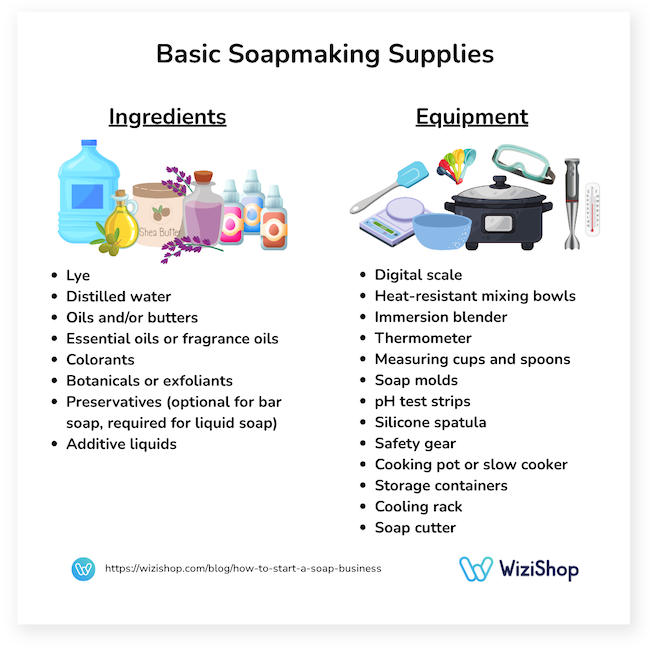
Don’t forget that proper storage for lye and other chemicals is critical for safety, along with fire extinguishers and personal protective equipment like gloves, goggles, and protective clothing.
It’s also a good idea to provide space for cooling racks, plus packaging supplies like labels, wrapping materials, and storage containers for finished products.
A well-organized, dedicated workspace promotes consistency, product safety, and efficiency—laying the foundation for a smooth and scalable soapmaking operation.
8. Develop and test your products
You’re now ready to put the finishing touches on your soap recipes, ensuring they produce a stable, effective, and skin-safe product. This includes choosing your base oils, lye ratios, additives, and scents.
Testing different scent combinations and ingredients helps create a product line that appeals to customers.
Before selling, you should also conduct tests for shelf life to verify that the soap maintains its quality over time without discoloration, scent loss, or spoilage.
Safety testing is essential to check for skin irritation or allergic reactions, especially when using fragrances or essential oils.
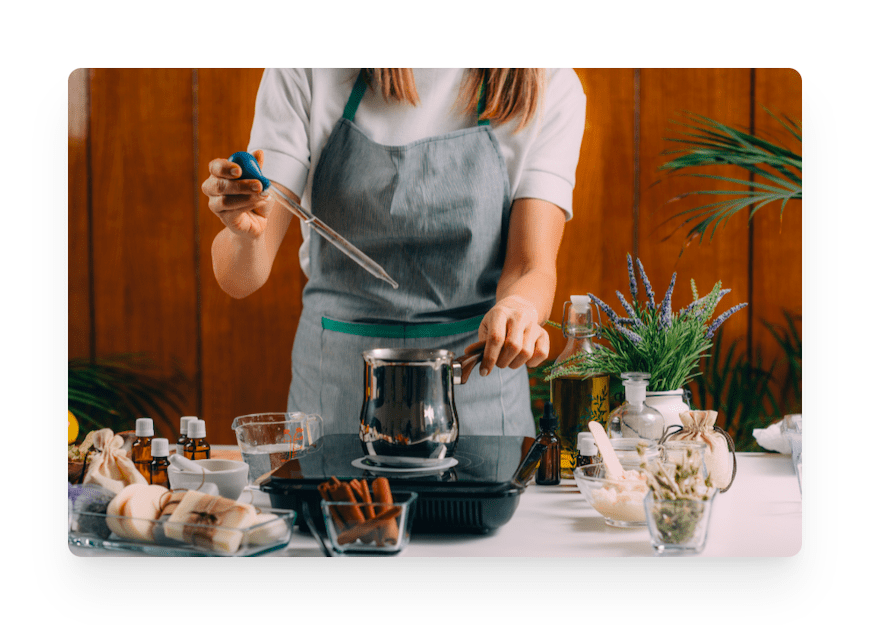
Finally, test your products with real users to gather feedback on performance, scent, and skin feel. This process ensures customer satisfaction, helps build brand trust, and reduces the risk of complaints or legal issues.
Once your recipes are set, your packaging must also be finalized.
We briefly mentioned packaging earlier when discussing how to define your niche and brand, but this is the moment to perfect this key component.
Here are a few tips to help you design stellar product packaging for your soap products:
- Prioritize clear and compliant labeling: Make sure your packaging includes all required information, such as ingredients, weight, business name, and contact info. If your soap is cosmetic or drug-regulated, follow FDA labeling guidelines. Clarity builds trust and ensures legal compliance.
- Reflect your brand identity: Use colors, fonts, and design elements that match your brand’s personality—whether it’s natural, luxurious, playful, or eco-friendly. Well-designed packaging makes your product stand out on shelves and appeals to your target audience.
- Choose functional and eco-friendly materials: Select packaging that will keep the soap safe during shipping and storage, while also being easy for customers to open and reuse or recycle. Sustainable options like kraft paper, cardboard sleeves, or biodegradable wraps are especially popular with today’s eco-conscious shoppers.
9. Choose your sales channels
You’re so close to being able to start offering your cleansing creations to the world!
You just need to decide if you want to sell in person or online.
Selling your soap in person, say at craft fairs and farmers’ markets for instance, allows you to connect directly with customers, offer product samples, and receive immediate feedback.
Source: The Moher Soap Co.
It builds brand trust, boosts local exposure, and creates opportunities for repeat business through personal interaction and storytelling about your ingredients and process.
That being said, just using this strategy can limit your sales somewhat, as you’ll only be able to sell to the people you meet in that particular location.
In contrast, selling your soaps online makes it possible for you to reach a much larger group of consumers, without needing to meet shoppers in person to make a sale.
Although selling handmade goods like soap on the internet via online marketplaces like Etsy is popular with many makers, creating your own website to sell your products will ultimately give you the most freedom, control, and profit potential.
Using the WiziShop ecommerce solution, you can easily build a professional online store that suits the vision you have for your brand and start selling your collection of soap products to people all over the world ASAP!
Besides having access to a variety of customizable design templates to create a visually appealing homepage, you’ll be able to avail of the platform’s powerful artificial intelligence to create compelling product pages in just a few clicks.

The AI can also assist you in generating all kinds of other text content for your website and marketing, such as translations, blog articles, social media posts, ad copy, and more, leaving you with more time to work on other areas of your business, e.g., developing fantastic new soap recipes!
Furthermore, you’ll automatically benefit from 50+ SEO features to optimize your online store’s technical SEO, helping you climb the rankings on Google, along with 400+ pre-integrated tools to boost your soap sales.
Create your WiziShop account today and take advantage of a 7-day free trial!
Try WiziShop free for 7 days
THE EASIEST NO-CODE ECOMMERCE SOLUTION✅ No credit card required
✅ Access to all features
✅ No commitment
10. Launch and promote your business
Finally, you’re ready to make your products available for sale and actively reach out to your target audience.
Be sure to create social media profiles on platforms like Instagram, Facebook, or TikTok where your ideal customers spend time.
Here, you can share content that showcases your products, behind-the-scenes soap making, ingredient highlights, and customer testimonials to build trust and interest.
Source: Soap Distillery
Source: Donegal Natural Soap
Engage with your audience by responding to comments and messages to build a loyal community.
Note that networking with other small business owners, especially in your area or niche, can lead to valuable collaborations and referrals.
Source: A Wild Soap Bar
Pay close attention to customer feedback—whether through reviews, direct comments, or in-person conversations—and use it to refine your products and marketing strategies.
A strong launch builds momentum and sets the foundation for long-term growth and success!


![How to start a soap business: Complete 10-step guide for success [2025]](https://wizishop.com/media/68249db269c3e23c940c5477/v1/how-to-start-a-soap-business-wizishop.jpg)







